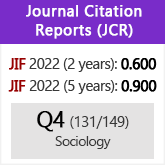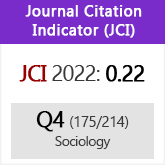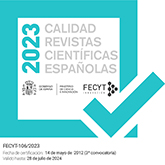Are cohabiting and being married different? Comparing 1991 and 2001 Spanish Population Censuses
DOI:
https://doi.org/10.3989/ris.2007.i48.68Keywords:
Censuses, Cohabitation, Partnership, Spain, YouthAbstract
The objective of this paper is to establish whether there are socio-demographic differences between young couples who are cohabiting and those who are married in Spain. Data sources are the 1991 and 2001 population censuses. The age range is 20-39 years. As the dependent variable is a binary variable (cohabiting versus being married), logistic regression will be used for the analysis. A separate model for each sex and for each year is estimated. Based on the results, it is observed that on average cohabitors have different characteristics than those who are married. Cohabiting couples have fewer children, are younger and show a higher age gap between the partners. Consensual unions are more likely to rent a dwelling. They present a higher proportion where just the woman is working or both partners are not working. They also have higher educational attainment and greater educational differences between the partners. While the structure of the cohabiting population has changed substantially between 1991 and 2001, the model has not.
Downloads
References
Alberdi, I., LL. Flaquer y J. Iglesias de Ussel (1994), Parejas y matrimonios. Actitudes, comportamientos y experiencias, Madrid, Ministerio de Asuntos Sociales.
Baizán, P., F. Michielin y F. Billari (2002), “Political economy and lifecourse patterns: the heterogeneity of occupational, family and household trajectories of young Spaniards”, Demographic Research, nº. 6, article 8, pp. 189-240.
Baizán, P., A. Aassve y F. Billari (2003), “Cohabitation, Marriage and First Birth: The interrelationship of Family Formation Events in Spain”, European Journal of Population, nº 19, pp. 147-169. doi:10.1023/A:1023343001627
Delgado, M. (1993), “Cambios recientes en el proceso de formación de la familia”, Revista Española de Investigaciones sociológicas, nº 64, pp. 123-153.
Delgado, M. (2002), “La fecundidad en España a fines del siglo XX”, Sistema, nº 175-6, pp. 87-112.
Durán, M. A. (2000) (dir), La contribución del trabajo no remunerado a la economía española: alternativas metodológicas, Madrid, Instituto de la Mujer, colección Estudios, nº 63.
Esteve, A. y C. Cortina (2005), “Homogamia educativa en la España contemporánea: pautas y tendencias”, Papers de demografia, nº 257.
Jovell (1995), Análisis de regresión logística, Madrid, Centro de Investigaciones Sociológicas.
Meil, G. (1997), “La participación masculina en el cuidado de los hijos en la nueva familia urbana española”, Papers, núm. 53, pp. 77-99.
Meil, G. (1999), La postmodernización de la familia española, Madrid, Acento.
Meil, G. (2003), Las uniones de hecho en España, Madrid, Centro de Investigaciones Sociológicas y Siglo XXI.
Menacho, T. (2002), Los tipos de estandarización en demografía. Aplicación al estudio de las diferencias regionales de la actividad y desempleo en España, 1990-2000, Memoria de investigación de tercer ciclo, Departament de Geografía, Universitat Autònoma de Barcelona, mimeo.
Miret, P. y A. Cabré (2005), “Pautas recientes en la formación familiar en España: Constitución de la pareja y fecundidad”, Papeles de Economía Española, nº 104, pp 17-36.
Roussel, L. (1989), La famille incertaine, París, Odele Jacob.
Toharia, L. (2004), “Estructura demográfica y actividades de las personas”, en Leal, J. (coordinador), Informe sobre la situación demográfica en España, Madrid, Fundación Abril Martorell.
Van de Kaa, D. (1987), “Europe’s Second Demographic Transition”, Population Bulletin, vol. 42, nº 1, Population Reference Bureau, Washington.
Downloads
Published
How to Cite
Issue
Section
License
Copyright (c) 2007 Consejo Superior de Investigaciones Científicas (CSIC)

This work is licensed under a Creative Commons Attribution 4.0 International License.
© CSIC. Manuscripts published in both the printed and online versions of this Journal are the property of Consejo Superior de Investigaciones Científicas, and quoting this source is a requirement for any partial or full reproduction.All contents of this electronic edition, except where otherwise noted, are distributed under a “Creative Commons Attribution 4.0 International” (CC BY 4.0) License. You may read here the basic information and the legal text of the license. The indication of the CC BY 4.0 License must be expressly stated in this way when necessary.
Self-archiving in repositories, personal webpages or similar, of any version other than the published by the Editor, is not allowed.

















